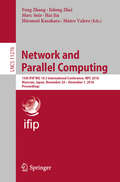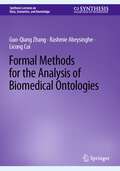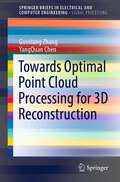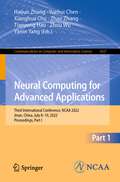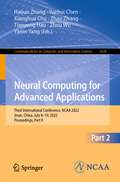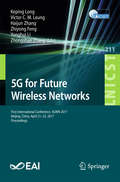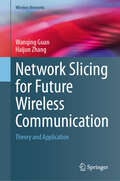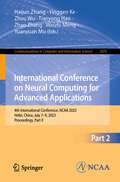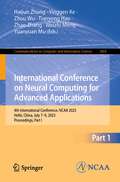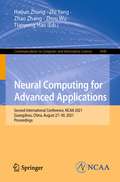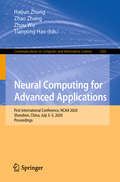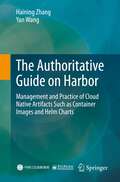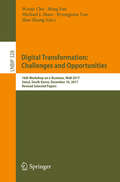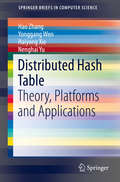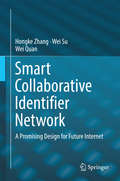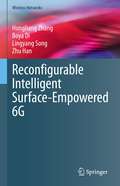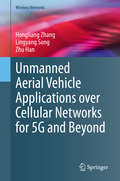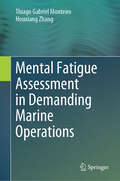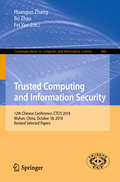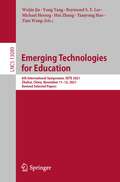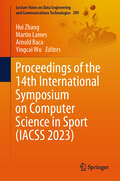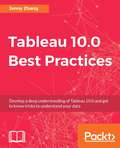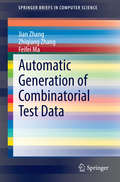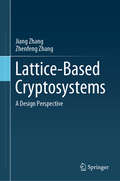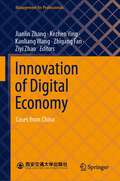- Table View
- List View
Network and Parallel Computing: IFIP International Conference, NPC 2007, Dalian, China, September 18-21, 2007, Proceedings (Lecture Notes in Computer Science #4672)
by Feng Zhang Jidong Zhai Marc Snir Hai Jin Hironori Kasahara Mateo ValeroThis book constitutes the proceedings of the 15th IFIP International Conference on Network and Parallel Computing, NPC 2018, held in Muroran, Japan, in November/December 2018. <P><P>The 22 full and 12 short papers presented in this volume were carefully reviewed and selected from 72 submissions. The papers cover traditional areas of network and parallel computing, including parallel applications, distributed algorithms, parallel architectures, software environments, and distributed tools.
Formal Methods for the Analysis of Biomedical Ontologies (Synthesis Lectures on Data, Semantics, and Knowledge)
by Guo-Qiang Zhang Rashmie Abeysinghe Licong CuiThe book synthesizes research on the analysis of biomedical ontologies using formal concept analysis, including through auditing, curation, and enhancement. As the evolution of biomedical ontologies almost inevitably involves manual work, formal methods are a particularly useful tool for ontological engineering and practice, particularly in uncovering unexpected "bugs" and content materials. The book first introduces simple but formalized strategies for discovering undesired and incoherent patterns in ontologies before exploring the application of formal concept analysis for semantic completeness. The book then turns to formal concept analysis, a classical approach used in the mathematical treatment of orders and lattices, as an ontological engineering principle, focusing on the structural property of ontologies with respect to its conformation to lattice or not (non-lattice). The book helpfully covers the development of more efficient algorithms for non-lattice detection and extraction required by exhaustive lattice/non-lattice analysis. The book goes on to highlight the power and utility of uncovering non-lattice structure for debugging ontologies and describes methods that leverage the linguistic information in concept names (labels) for ontological analysis. It also addresses visualization and performance evaluation issues before closing with an overview and forward-looking perspectives on the field. This book is intended for graduate students and researchers interested in biomedical ontologies and their applications. It can be a useful supplement for courses on knowledge representation and engineering and also provide readers with a reference for related scientific publications and literature to assist in identifying potential research topics. All mathematical concepts and notations used in this book can be found in standard discrete mathematics textbooks, and the appendix at the end of the book provides a list of key ontological resources, as well as annotated non-lattice and lattice examples that were discovered using the authors' methods, demonstrating how "bugs are fixed" by converting non-lattices to lattices with minimal edit changes.
Towards Optimal Point Cloud Processing for 3D Reconstruction (SpringerBriefs in Electrical and Computer Engineering)
by Guoxiang Zhang YangQuan ChenThis SpringerBrief presents novel methods of approaching challenging problems in the reconstruction of accurate 3D models and serves as an introduction for further 3D reconstruction methods. It develops a 3D reconstruction system that produces accurate results by cascading multiple novel loop detection, sifting, and optimization methods.The authors offer a fast point cloud registration method that utilizes optimized randomness in random sample consensus for surface loop detection. The text also proposes two methods for surface-loop sifting. One is supported by a sparse-feature-based optimization graph. This graph is more robust to different scan patterns than earlier methods and can cope with tracking failure and recovery. The other is an offline algorithm that can sift loop detections based on their impact on loop optimization results and which is enabled by a dense map posterior metric for 3D reconstruction and mapping performance evaluation works without any costly ground-truth data. The methods presented in Towards Optimal Point Cloud Processing for 3D Reconstruction will be of assistance to researchers developing 3D modelling methods and to workers in the wide variety of fields that exploit such technology including metrology, geological animation and mass customization in smart manufacturing.
Neural Computing for Advanced Applications: Third International Conference, NCAA 2022, Jinan, China, July 8–10, 2022, Proceedings, Part I (Communications in Computer and Information Science #1637)
by Haijun Zhang Yuehui Chen Xianghua Chu Zhao Zhang Tianyong Hao Zhou Wu Yimin YangThe two-volume Proceedings set CCIS 1637 and 1638 constitutes the refereed proceedings of the Third International Conference on Neural Computing for Advanced Applications, NCAA 2022, held in Jinan, China, during July 8–10, 2022. The 77 papers included in these proceedings were carefully reviewed and selected from 205 submissions. These papers were categorized into 10 technical tracks, i.e., neural network theory, and cognitive sciences, machine learning, data mining, data security & privacy protection, and data-driven applications, computational intelligence, nature-inspired optimizers, and their engineering applications, cloud/edge/fog computing, the Internet of Things/Vehicles (IoT/IoV), and their system optimization, control systems, network synchronization, system integration, and industrial artificial intelligence, fuzzy logic, neuro-fuzzy systems, decision making, and their applications in management sciences, computer vision, image processing, and their industrial applications, natural language processing, machine translation, knowledge graphs, and their applications, Neural computing-based fault diagnosis, fault forecasting, prognostic management, and system modeling, and Spreading dynamics, forecasting, and other intelligent techniques against coronavirus disease (COVID-19).
Neural Computing for Advanced Applications: Third International Conference, NCAA 2022, Jinan, China, July 8–10, 2022, Proceedings, Part II (Communications in Computer and Information Science #1638)
by Haijun Zhang Yuehui Chen Xianghua Chu Zhao Zhang Tianyong Hao Zhou Wu Yimin YangThe two-volume Proceedings set CCIS 1637 and 1638 constitutes the refereed proceedings of the Third International Conference on Neural Computing for Advanced Applications, NCAA 2022, held in Jinan, China, during July 8–10, 2022. The 77 papers included in these proceedings were carefully reviewed and selected from 205 submissions. These papers were categorized into 10 technical tracks, i.e., neural network theory, and cognitive sciences, machine learning, data mining, data security & privacy protection, and data-driven applications, computational intelligence, nature-inspired optimizers, and their engineering applications, cloud/edge/fog computing, the Internet of Things/Vehicles (IoT/IoV), and their system optimization, control systems, network synchronization, system integration, and industrial artificial intelligence, fuzzy logic, neuro-fuzzy systems, decision making, and their applications in management sciences, computer vision, image processing, and their industrial applications, natural language processing, machine translation, knowledge graphs, and their applications, Neural computing-based fault diagnosis, fault forecasting, prognostic management, and system modeling, and Spreading dynamics, forecasting, and other intelligent techniques against coronavirus disease (COVID-19).
5G for Future Wireless Networks: First International Conference, 5GWN 2017, Beijing, China, April 21-23, 2017, Proceedings (Lecture Notes of the Institute for Computer Sciences, Social Informatics and Telecommunications Engineering #211)
by Haijun Zhang Zhiyong Feng Victor C.M. Leung Yonghui Li Keping Long Zhongshan ZhangThis book constitutes the proceedings of the First International Conference on 5G for Future Wireless Networks, 5GWN 2017, held in Beijing, China, in April 2017. The 64 full papers were selected from 135 submissions and present the state of the art and practical applications of 5G technologies. The exponentially growing data traffic caused by the development of mobile Internet and smart phones requires powerful networks. The fifth generation (5G) techniques are promising to meet the requirements of this explosive data traffic in future mobile communications.
Network Slicing for Future Wireless Communication: Theory and Application (Wireless Networks)
by Haijun Zhang Wanqing GuanThis book comprehensively discusses the development, application and challenges of network slicing technology in wireless communications. Starting with the basic concept and enabling technologies of network slicing, this book introduces how to integrate AI (Artificial Intelligence) technology into the end-to-end deployment, resource allocation and performance enhancement for multi-tenant slicing. An in-depth exploration of managing multi-domain slices deployed in the federated infrastructure networks is presented, including on-demand cooperation among multiple infrastructure networks, distinct slice deployment, hierarchical slice orchestration and fast slice adaption. As a guide to leveraging AI to enhance traffic performance of multi-tenant slicing and customize resource slicing for industrial scenarios, this book provides insights, modeling, applications and research issues. A holistic perspective on prominent role of network slicing in managing wireless network resources is provided as well. Overall, network slicing as a key technology of wireless networks, enables to satisfy differentiated service demands of multiple tenants from vertical industries with the same shared physical infrastructure network. As future wireless networks are expected to facilitate the evolution of vertical industries, various vertical enterprises as tenants require an intelligent network slicing paradigm to provide highly customizable services. AI-based management system for network slicing excel at deploying slices rapidly, allocating resources efficiently and avoiding service quality degradation. With the increasing diversity of service demands and complexity of communication environment, incorporating AI into network slicing is a necessity for improving flexibility and automation of resource management. This book targets advanced-level students in information and communication sciences as a secondary textbook. Researchers and industry professionals working in various areas, such as wireless communication systems, network management and orchestration, resource allocation and AI-enabled wireless networks will also find this book useful as reference book.
International Conference on Neural Computing for Advanced Applications: 4th International Conference, NCAA 2023, Hefei, China, July 7–9, 2023, Proceedings, Part II (Communications in Computer and Information Science #1870)
by Haijun Zhang Yinggen Ke Zhou Wu Tianyong Hao Zhao Zhang Weizhi Meng Yuanyuan MuThe two-volume set CCIS 1869 and 1870 constitutes the refereed proceedings of the 4th International Conference on Neural Computing for Advanced Applications, NCAA 2023, held in Hefei, China, in July 2023.The 83 full papers and 1 short paper presented in these proceedings were carefully reviewed and selected from 211 submissions. The papers have been organized in the following topical sections: Neural network (NN) theory, NN-based control systems, neuro-system integration and engineering applications; Machine learning and deep learning for data mining and data-driven applications; Computational intelligence, nature-inspired optimizers, and their engineering applications; Deep learning-driven pattern recognition, computer vision and its industrial applications; Natural language processing, knowledge graphs, recommender systems, and their applications; Neural computing-based fault diagnosis and forecasting, prognostic management, and cyber-physical system security; Sequence learning for spreading dynamics, forecasting, and intelligent techniques against epidemic spreading (2); Applications of Data Mining, Machine Learning and Neural Computing in Language Studies; Computational intelligent Fault Diagnosis and Fault-Tolerant Control, and Their Engineering Applications; and Other Neural computing-related topics.
International Conference on Neural Computing for Advanced Applications: 4th International Conference, NCAA 2023, Hefei, China, July 7–9, 2023, Proceedings, Part I (Communications in Computer and Information Science #1869)
by Haijun Zhang Yinggen Ke Zhou Wu Tianyong Hao Zhao Zhang Weizhi Meng Yuanyuan MuThe two-volume set CCIS 1869 and 1870 constitutes the refereed proceedings of the 4th International Conference on Neural Computing for Advanced Applications, NCAA 2023, held in Hefei, China, in July 2023.The 83 full papers and 1 short paper presented in these proceedings were carefully reviewed and selected from 211 submissions. The papers have been organized in the following topical sections: Neural network (NN) theory, NN-based control systems, neuro-system integration and engineering applications; Machine learning and deep learning for data mining and data-driven applications; Computational intelligence, nature-inspired optimizers, and their engineering applications; Deep learning-driven pattern recognition, computer vision and its industrial applications; Natural language processing, knowledge graphs, recommender systems, and their applications; Neural computing-based fault diagnosis and forecasting, prognostic management, and cyber-physical system security; Sequence learning for spreading dynamics, forecasting, and intelligent techniques against epidemic spreading (2); Applications of Data Mining, Machine Learning and Neural Computing in Language Studies; Computational intelligent Fault Diagnosis and Fault-Tolerant Control, and Their Engineering Applications; and Other Neural computing-related topics.
Neural Computing for Advanced Applications: Second International Conference, NCAA 2021, Guangzhou, China, August 27-30, 2021, Proceedings (Communications in Computer and Information Science #1449)
by Haijun Zhang Zhi Yang Zhao Zhang Zhou Wu Tianyong HaoThis book presents refereed proceedings of the Second International Conference Neural Computing for Advanced Applications, NCAA 2021, held in Guangzhou, China, in August, 2021. The 54 full papers papers were thorougly reviewed and selected from a total of 144 qualified submissions. The papers are organized in topical sections on neural network theory, cognitive sciences, neuro-system hardware implementations, and NN-based engineering applications; machine learning, data mining, data security and privacy protection, and data-driven applications; neural computing-based fault diagnosis, fault forecasting, prognostic management, and system modeling; computational intelligence, nature-inspired optimizers, and their engineering applications; fuzzy logic, neuro-fuzzy systems, decision making, and their applications in management sciences; control systems, network synchronization, system integration, and industrial artificial intelligence; computer vision, image processing, and their industrial applications; cloud/edge/fog computing, the Internet of Things/Vehicles(IoT/IoV), and their system optimization; spreading dynamics, forecasting, and other intelligent techniques against coronavirus disease (COVID-19).
Neural Computing for Advanced Applications: First International Conference, NCAA 2020, Shenzhen, China, July 3–5, 2020, Proceedings (Communications in Computer and Information Science #1265)
by Haijun Zhang Zhao Zhang Tianyong Hao Zhou WuThis book presents refereed proceedings of the First International Conference Neural Computing for Advanced Applications, NCAA 2020, held in July, 2020. Due to the COVID-19 pandemic the conference was held online. The 36 full papers and 7 short papers were thorougly reviewed and selected from a total of 113 qualified submissions. Thes papers present resent research on such topics as neural network theory, and cognitive sciences, machine learning, data mining, data security & privacy protection, and data-driven applications, computational intelligence, nature-inspired optimizers, and their engineering applications, cloud/edge/fog computing, the Internet of Things/Vehicles (IoT/IoV), and their system optimization, control systems, network synchronization, system integration, and industrial artificial intelligence, fuzzy logic, neuro-fuzzy systems, decision making, and their applications in management sciences, computer vision, image processing, and their industrial applications, and natural language processing, machine translation, knowledge graphs, and their applications.
The Authoritative Guide on Harbor: Management and Practice of Cloud Native Artifacts Such as Container Images and Helm Charts
by Haining Zhang Yan WangHarbor is a major CNCF open source project, with thousands of production users all over the world. This book provides a comprehensive explanation of the open source cloud native registry: Harbor. Written by experts who contributed to and now maintain Harbor, the content covers its architecture, principles, functions, deployment and configuration, scanning artifacts, remote replication, operation and maintenance, customized development, API usage and success stories. The book offers a valuable guide for Harbor users, developers and contributors, cloud native software development engineers, test engineers, operational and maintenance engineers, IT architects and IT technical managers. It will also benefit university students in computer-related disciplines.
Digital Transformation: 16th Workshop On E-business, Web 2017, Seoul, South Korea, December 10, 2017, Revised Selected Papers (Lecture Notes in Business Information Processing #328)
by Han Zhang Byungjoon Yoo Michael J. Shaw Ming Fan Wooje ChoThis book constitutes revised selected papers from the 16th Workshop on e-Business, WeB 2017, which took place in Seoul, South Korea, in December 2017. The purpose of WeB is to provide an open forum for e-Business researchers and practitioners world-wide, to share topical research findings, explore novel ideas, discuss success stories and lessons learned, map out major challenges, and collectively chart future directions for e-Business. The WeB 2017 theme was “Digital transformation: challenges and opportunities”. The 11 papers presented in this volume were carefully reviewed and selected from 43 submissions. These are original research articles with a broad coverage of behavioral issues on consumers, citizens, businesses, industries and governments, ranging from technical to strategic issues.
Distributed Hash Table
by Hao Zhang Yonggang Wen Haiyong Xie Nenghai YuThis SpringerBrief summarizes the development of Distributed Hash Table in both academic and industrial fields. It covers the main theory, platforms and applications of this key part in distributed systems and applications, especially in large-scale distributed environments. The authors teach the principles of several popular DHT platforms that can solve practical problems such as load balance, multiple replicas, consistency and latency. They also propose DHT-based applications including multicast, anycast, distributed file systems, search, storage, content delivery network, file sharing and communication. These platforms and applications are used in both academic and commercials fields, making Distributed Hash Table a valuable resource for researchers and industry professionals.
Smart Collaborative Identifier Network
by Hongke Zhang Wei Su Wei QuanThis book introduces a promising design for future Internet, the Smart Collaborative Identifier NETwork (SINET). By examining cutting-edge research from around the world, it is the first book to provide a comprehensive survey of SINET, including its basic theories and principles, a broad range of architectures, protocols, standards, and future research directions. For further investigation, the book also provides readers an experimental analysis of SINET to promote further, independent research. The second part of the book presents in detail key technologies in SINET such as scalable routing, efficient mapping systems, mobility management and security issues. In turn, the last part presents various implementations of SINET, assessing its merits. The authors believe SINET will greatly benefit researchers involved in designing future Internet thanks to its high degree of flexibility, security, manageability, mobility support and efficient resource utilization.
Reconfigurable Intelligent Surface-Empowered 6G (Wireless Networks)
by Hongliang Zhang Boya Di Lingyang Song Zhu HanThis book presents novel RIS-Based Smart Radio techniques, targeting at achieving high-quality channel links in cellular communications via design and optimization of the RIS construction. Unlike traditional antenna arrays, three unique characteristics of the RIS will be revealed in this book. First, the built-in programmable configuration of the RIS enables analog beamforming inherently without extra hardware or signal processing. Second, the incident signals can be controlled to partly reflect and partly transmit through the RIS simultaneously, adding more flexibility to signal transmission. Third, the RIS has no digital processing capability to actively send signals nor any radio frequency (RF) components. As such, it is necessary to develop novel channel estimation and communication protocols, design joint digital and RIS-based analog beamforming schemes and perform interference control via mixed reflection and transmission. This book also investigates how to integrate the RIS to legacy communication systems. RIS techniques are further investigated in this book (benefited from its ability to actively shape the propagation environment) to achieve two types of wireless applications, i.e., RF sensing and localization. The influence of the sensing objectives on the wireless signal propagation can be potentially recognized by the receivers, which are then utilized to identify the objectives in RF sensing. Unlike traditional sensing techniques, RIS-aided sensing can actively customize the wireless channels and generate a favorable massive number of independent paths interacting with the sensing objectives. It is desirable to design RIS-based sensing algorithms, and optimize RIS configurations. For the second application, i.e., RIS aided localization, an RIS is deployed between the access point (AP) and users. The AP can then analyze reflected signals from users via different RIS configurations to obtain accurate locations of users. However, this is a challenging task due to the dynamic user topology, as well as the mutual influence between multiple users and the RIS. Therefore, the operations of the RIS, the AP, and multiple users need to be carefully coordinated. A new RIS-based localization protocol for device cooperation and an RIS configuration optimization algorithm are also required. This book targets researchers and graduate-level students focusing on communications and networks. Signal processing engineers, computer and information scientists, applied mathematicians and statisticians, who work in RIS research and development will also find this book useful.
Unmanned Aerial Vehicle Applications over Cellular Networks for 5G and Beyond (Wireless Networks)
by Hongliang Zhang Lingyang Song Zhu HanThis book discusses how to plan the time-variant placements of the UAVs served as base station (BS)/relay, which is very challenging due to the complicated 3D propagation environments, as well as many other practical constraints such as power and flying speed. Spectrum sharing with existing cellular networks is also investigated in this book. The emerging unmanned aerial vehicles (UAVs) have been playing an increasing role in the military, public, and civil applications. To seamlessly integrate UAVs into future cellular networks, this book will cover two main scenarios of UAV applications as follows. The first type of applications can be referred to as UAV Assisted Cellular Communications.Second type of application is to exploit UAVs for sensing purposes, such as smart agriculture, security monitoring, and traffic surveillance. Due to the limited computation capability of UAVs, the real-time sensory data needs to be transmitted to the BS for real-time data processing. The cellular networks are necessarily committed to support the data transmission for UAVs, which the authors refer to as Cellular assisted UAV Sensing. To support real-time sensing streaming, the authors design joint sensing and communication protocols, develop novel beamforming and estimation algorithms, and study efficient distributed resource optimization methods.This book targets signal processing engineers, computer and information scientists, applied mathematicians and statisticians, as well as systems engineers to carve out the role that analytical and experimental engineering has to play in UAV research and development. Undergraduate students, industry managers, government research agency workers and general readers interested in the fields of communications and networks will also want to read this book.
Mental Fatigue Assessment in Demanding Marine Operations
by Houxiang Zhang Thiago Gabriel MonteiroThis book investigates how human mental fatigue (MF) can be objectively measured during demanding maritime operations. The maritime domain is characterized by demanding operations. These operations can be especially complex and dangerous when they require coordination between different maritime vessels and several maritime operators. The best approach to quantify MF is through the use of physiological sensors including electroencephalogram (EEG), electrocardiogram, electromyogram, temperature sensor, and eye tracker can be applied, individually or in conjunction, in order to collect relevant data that can be mapped to an MF scale. More than simpler sensor fusion, this book bridges the gap between relevant sensor data and a quantifiable MF level using both data-driven and model-based approaches. Data-driven part investigates the use of different NNs combined for the MF assessment (MFA) task. Among the different architectures tested, convolutional neural networks (CNN) showed the best performance when dealing with multiple physiological data channels. Optimization was used to improve the performance of CNN in the cross-subject MFA task. Testing different combinations of physiological sensors indicated a setup consisting of EEG sensor only was the best option, due to the trade-off between assessment precision and sensor framework complexity. These two factors are of great importance when considering an MFA system that could be implemented in real-life scenarios. The model-based discussion applies the current knowledge about the use of EEG data to characterize MF to develop an MF approach to quantify the progression of MF in maritime operators. In the research presented in this book, realistic vessel simulators were used as a platform for experimenting with different operational scenarios and sensor setups.
Trusted Computing and Information Security: 12th Chinese Conference, CTCIS 2018, Wuhan, China, October 18, 2018, Revised Selected Papers (Communications in Computer and Information Science #960)
by Huanguo Zhang Bo Zhao Fei YanThis book constitutes the refereed proceedings of the Chinese Conference on Trusted Computing and Information Security, CTCIS 2018, held in Wuhan, China, in October 2018.The 24 revised full papers presented were carefully reviewed and selected from 73 submissions. The papers are centered around cryptography, systems security, trusted computing, information security, and network security.
Emerging Technologies for Education: 6th International Symposium, SETE 2021, Zhuhai, China, November 11–12, 2021, Revised Selected Papers (Lecture Notes in Computer Science #13089)
by Hui Zhang Weijia Jia Tianyong Hao Yong Tang Raymond S. T. Lee Michael Herzog Tian WangThis book constitutes the refereed conference proceedings of the 6th International Symposium on Emerging Technologies for Education, SETE 2021, held in Zhuhai, China in November 2021. 35 full papers were accepted together with 8 short papers out of 58 submissions. The papers focus on the following subjects: Emerging Technologies for Education, Digital Technology, Creativity, and Education; Education Technology (Edtech) and ICT for Education; Education + AI; Adaptive Learning, Emotion and Behaviour Recognition and Understanding in Education; as well as papers from the International Symposium on User Modeling and Language Learning (UMLL2021) and the International Workshop on Educational Technology for Language Learning (ETLL 2021).
Proceedings of the 14th International Symposium on Computer Science in Sport (Lecture Notes on Data Engineering and Communications Technologies #209)
by Hui Zhang Martin Lames Arnold Baca Yingcai WuThis book is a compilation of selected papers from the 14th International Symposium on Computer Science in Sport (IACSS 2023), held on September 27-30, 2023 in Hangzhou, China. The work focuses on the application of computer science and technology in the field of sports (such as intelligent data collection, data mining, visual analysis of game data, virtual reality, machine learning, computer vision, match prediction models and performance analysis). The contents make valuable contributions to academic researchers, college students, coaches and athletes, and sports management personnel (such as managers of sports associations, training bases, and professional clubs). Additionally, readers will encounter new ideas for realizing a more efficient and convenient training and exercise system.
Tableau 10.0 Best Practices
by Jenny ZhangDevelop a deep understanding of Tableau 10.0 and get to know tricks to understand your data About This Book • Quickly learn tips, tricks, and best practices about Tableau from Tableau masters • Whether it is data blending or complex calculations, you can solve your problem with ease and confidence; no more searching for a help doc or waiting for support • If you want to quickly master Tableau, then this book is for you Who This Book Is For This book is for Tableau users who have a basic to average understanding of the various features available in Tableau. You'll find this book useful if you spend a lot of time conducting data analysis and visualizations with Tableau. What You Will Learn • Connect to variety of data (cloud and local) and blend it in an efficient way for fast analytics • Advanced calculations such as LOD calculations and Table calculations • See advanced use cases of Parameter, Sorting, and Filters • Get practical tips on how to format dashboards following the Zen of dashboard design • See examples of a variety of visualizations such as cohort analysis, Jitters chart, and multiple small charts • See the new features in Tableau 10—cross data source filter, worksheet as tooltip, cluster, and custom territory In Detail Tableau has emerged as an industry leader in the field of data discovery and business analytic software solutions. While there is a lot of information on how to use the tool, most Tableau users are faced with the challenge on how it can be effectively used to derive meaningful business insights from the uncharted territory of data. This book will give you useful tips from Tableau masters learned from years of experience working with Tableau. You'll start by getting your data into Tableau, move on to generating progressively complex visualizations, and end with finishing touches and packaging your work for distribution. Inside you will learn the exact steps required to solve complex real-life problems. Whether it is data blending or complex calculations, you can solve your problem with ease and confidence; no more searching for Help doc or waiting for support. This book will help you make the most of Tableau and become a Tableau expert. Style and approach The book will show you hacks to solve complex real-life problems. This book will help you make the most of Tableau and become a Tableau expert. This book is packed with lots of real-life problems with step-by-step instructions from Tableau experts.
Automatic Generation of Combinatorial Test Data (SpringerBriefs in Computer Science)
by Jian Zhang Zhiqiang Zhang Feifei MaThis book reviews the state-of-the-art in combinatorial testing, with particular emphasis on the automatic generation of test data. It describes the most commonly used approaches in this area - including algebraic construction, greedy methods, evolutionary computation, constraint solving and optimization - and explains major algorithms with examples. In addition, the book lists a number of test generation tools, as well as benchmarks and applications. Addressing a multidisciplinary topic, it will be of particular interest to researchers and professionals in the areas of software testing, combinatorics, constraint solving and evolutionary computation.
Lattice-Based Cryptosystems: A Design Perspective
by Jiang Zhang Zhenfeng ZhangThis book focuses on lattice-based cryptosystems, widely considered to be one of the most promising post-quantum cryptosystems and provides fundamental insights into how to construct provably secure cryptosystems from hard lattice problems. The concept of provable security is used to inform the choice of lattice tool for designing cryptosystems, including public-key encryption, identity-based encryption, attribute-based encryption, key change and digital signatures. Given its depth of coverage, the book especially appeals to graduate students and young researchers who plan to enter this research area.
Innovation of Digital Economy: Cases from China (Management for Professionals)
by Jianlin Zhang Kezhen Ying Kanliang Wang Zhigang Fan Ziyi ZhaoThis book presents a rich selection of 36 real-world cases on how organizations in China explore the new growth pattern, business model innovation, and digital transformation in digital era. The topic of cases varies from digital marketing and Internet brands, the growth of digital platforms, digital transformation and the industrial Internet of things, strategies for cross-border e-commerce companies, and business model innovation in digital era, etc. These cases stem from a diverse set of industry sectors, reporting on best practices and lessons learned. The book shows how organizations strive to find new ways to develop and create new paths to grow in a digital world and shares essential practical insights into digital economy. All cases are presented in a standardized structure in order to provide valuable insights and essential guidance for practitioners, scholars as well as general readers.
